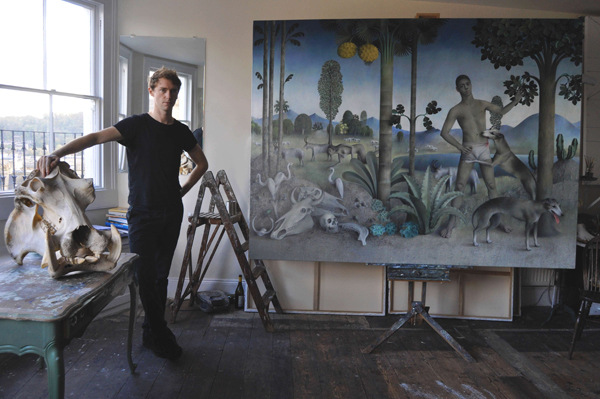At first glance, the world depicted in Land of Mortimer is a peaceful mythological idyll in which naked or semi-clad figures, in seemingly perpetual recreation, share their surroundings in harmony with animals and nature. They appear to be in what Jean-Jacques Rousseau described as “the indolence of our primitive state”. Furthermore, the skies are all blue, the trees are in leaf, ducks swim, deers frolic and sheep graze.
Look closer and you see a man making dubious advances towards a sheep or throwing another man from a balcony. There’s a sense of lawlessness in which inhibitions have been cast aside rendering man/woman into a primeval state where, as in Lord of the Flies, they’ve reverted to their basest instincts.
“You try to get as close to the first thought as you can,” says James Mortimer as we tour round his works in the James Freeman Gallery, his second solo exhibition there. “The best thing is to go with how your subconscious is dragged out of your mind and try not to ruin it by fiddling around too much.”
As a result, there’s a Freudian undercurrent of sexual tension – even the trees bearing ripening fruit are bursting with that same innuendo. “I try not to censor myself too much. I might go errgghh I shouldn’t have a man harassing a sheep because that could be misinterpreted,” Mortimer adds seemingly not worried that he’s going to be decried by animal rights activists!

There’s clearly a dark humour here that sits beside a certain child-like quality in the sense that Mortimer admits to a love of the kind of Where’s Wally or children’s adventure books in which little dramas are happening all over the place. In the case of Baboon, above, it’s less Where’s Wally, more Where’s Willy with the primate being clearly aroused by his capture of a crane.
The dramas tantalise. Is the figure on the right drowning the man or baptising him perhaps? Is the figure on the left by the bank alive or dead? Are the birds sympathising with him or exploiting him in his state? Has he also been put through the same ordeal as the other man? Is the gormless expression on the perpetrator benevolent or psychopathic? Why are they cutting down the tree? And why is there not a naked Theresa May running naughtily through the wheat field? If that thought had occurred to James Mortimer it was sensibly censored out!
A theme that runs through the narratives in Mortimer’s paintings is that of what happens next. Is the man going to club the sheep, what’s he doing with the dog and so on. “I quite like the idea of something about to happen. I’m not good at painting action, I don’t really like art that’s too melodramatic but I find it quite funny when something’s about to happen.”

So, in Shark Garden, the only ink drawing in the show, strange goings-on are taking place on balconies and in the maze. The main focus though is something that has happened. A shark, which has been landed having eaten a woman whole, has been cut open and the smiling woman saved. Unlike say in the works of Hieronymous Bosch which depict a similar renaissance-type surreal world in which all manner of depravity reigns, Mortimer’s paintings are not laden with symbolism. “The trouble with symbolism,” he says, “is it can mean anything.”

James Mortimer is a self-taught painter and studied sculpture at the bath School of Art, winning the Kenneth Armitage Prize for Sculpture in 2013. His bronze sculpture, Crocodile Head, featured in the Royal Academy 250th Summer Exhibition. He has exhibited internationally including solo shows at the Catto Gallery in London and the Accesso gallery in Pietrasanta in Italy.
His paintings often take weeks to finish, particularly as they include water. He uses various techniques here. Some parts of the lakes he paints contain reflections, others are smooth, some very painterly. He begins with a pink or orange wash in acrylic with blue oils on top to reach an undercolour. Then he applies gouache and thinned down watercolours until the right effect is reached after much trial and error. On the rocks, he has painted bird droppings from droppings themselves deposited by a pigeon on his studio windowsill, the first artist I have come across to use this raw material.
With his whole armoury of pen, paint and varnish, Land of Mortimer is the artist’s version of the Garden of Eden where freedom reigns but in which innocence has already been tainted by desire and temptation.
It runs at the James Freeman Gallery, 354 Upper Street, Islington, London N1 0PD until 2 March 2019.
All images are courtesy of the artist and gallery.

Leave a comment